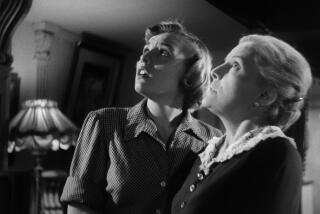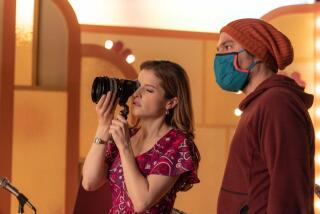âGreenawayâ at the Nuart: The Formative Years
âThe Featurettes,â the second and final program in âThe Early Films of Peter Greenawayâ (at the Nuart Tuesday and Wednesday), illuminates the formative years of one of the most brilliant and original--but also often most infuriating--filmmakers in the world. Possessed of a drier-than-dry British wit and a quite literally geometric passion for precision--and, alas, repetition--Greenaway first came to international renown with that 18th-Century comedy of manners and morals âThe Draughtsmanâs Contract.â
All the short films in the two-hour program anticipate in one aspect or another all the full-length Greenaway features to come, including his most recent, âProsperoâs Books.â
The 45-minute âVertical Features Remakeâ (1978) is a key film in the Greenaway canon and possibly the most enjoyable film he has ever made. It tells of the efforts of the fictional Institute of Reclamation and Restoration to reconstruct an experimental short, âVertical Features,â made by one Tulse Luper (clearly a Greenaway alter ego). Amid much hilarious academic sputtering, the group ends up assembling it in four slightly different ways. Each version offers a flow of awesomely beautiful landscapes in which the vertical is emphasized--trees, power lines, etc.--set to Michael Nymanâs oddly poignant, jangling score.
This and other films in the program should delight semanticists, for in all of them Greenaway seems to be reiterating the principal slogan of semantics: âThe Map Is Not the Territory.â One of the films, âA Walk Through H,â in fact sends up an obsession with maps, and therefore the entire passion to organize and classify and quantify; Greenaway quite clearly warns us about the dangers of not being able to see the forest for the trees. In âVertical Features Remake,â the academics nit-pick away yet all the four variations are equally beautiful; interestingly, in Greenawayâs hands a utility pole, normally something regarded as defacing to scenery, can become just as forceful an element in the composition of an image as a tree. Throughout âThe Featurettesâ offerings, we sense that he is attempting to reconcile nature and intellect. (310) 478-6379.
Finnish Fare: UCLA Film Archiveâs âShadows in Paradise: Films From Finland, 1948-1992â concludes Sunday in UCLAâs Melnitz Theater with Pirjo Honkasaloâs beautiful âMysterion,â which screens after the 7 p.m. presentation of the 90-minute âHomebound,â which was unavailable for preview. Divided into segments, to parallel beads on a rosary, this profoundly spiritual documentary charts a year in the life of an Estonian convent. Here, the women, who have the most serene expressions you will ever see, live an ancient, simple way of life, close to nature and to God. Ironically, their self-sustaining establishment with its extensive land holdings is an abundant oasis in a region overcome by pollution.
To watch âMysterionâ is like experiencing one of the sublime films of the late Andrei Tarkovsky.
Also screening Sunday: a Filmforum presentation at MOCA of some new films by Ernie Gehr, who experiments with dynamic relationships between perspective, camera movement and natural sound.
Information: (213) 626-6222.
More to Read
Only good movies
Get the Indie Focus newsletter, Mark Olsen's weekly guide to the world of cinema.
You may occasionally receive promotional content from the Los Angeles Times.










